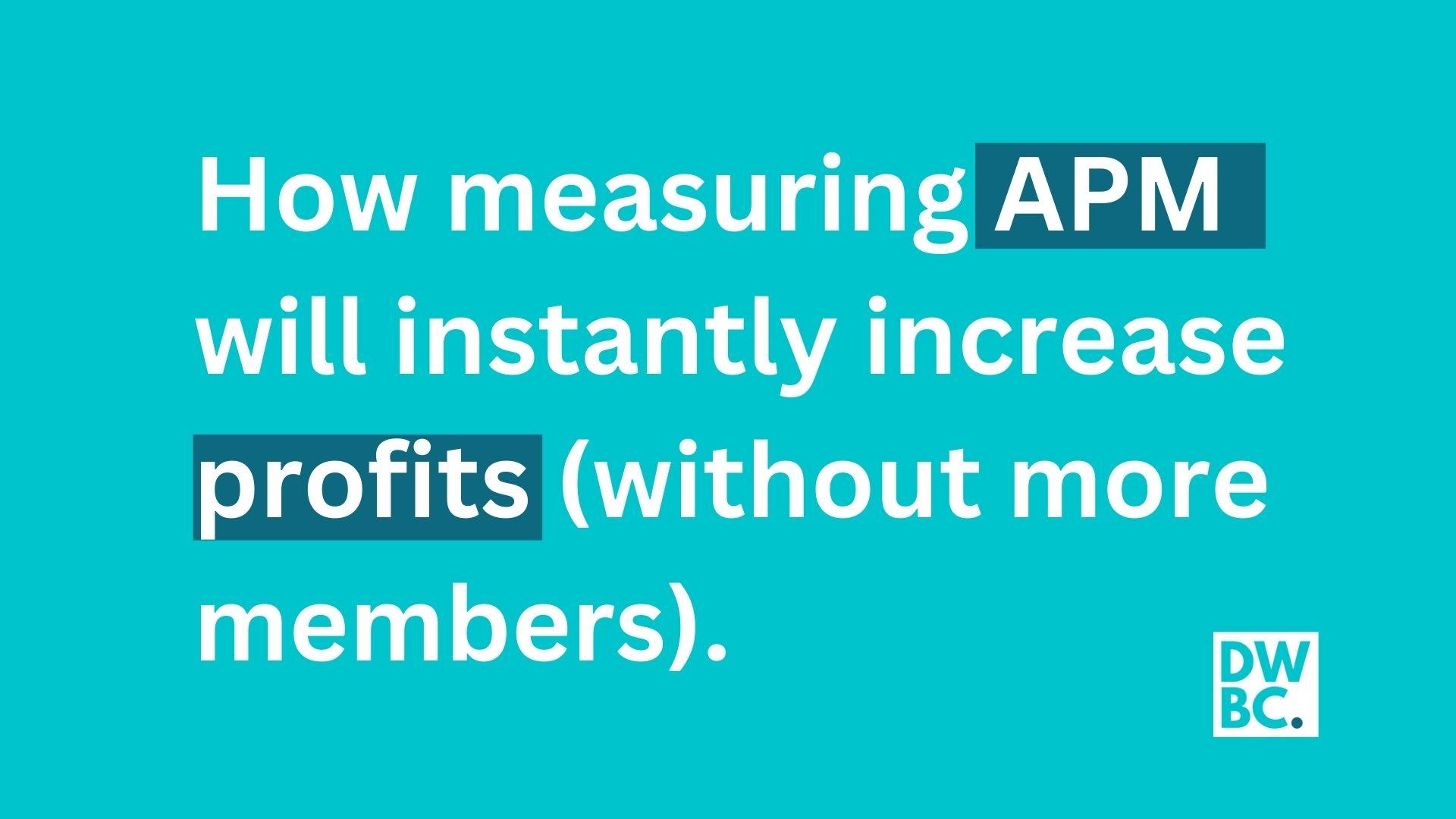- Fitness businesses focus too much on revenue, neglecting more important metrics like profit.
- Average profit per member (APM) is crucial for sustainable financial success.
- Increasing revenue without managing expenditure won’t improve profitability.
- Reducing expenditure can instantly boost profit more than chasing new clients.
- Prioritise retention and APM before focusing on client acquisition for long-term growth.
What is it with this fixation that fitness businesses have with revenue?
They’re so blinded by how many dollars are coming in each month, that they lose sight of a whole bunch of other metrics that are more important.
A ‘seven figure business’ is a business that brings in over a million dollars a year. A million dollars in revenue. Which sounds really impressive until you find out that expenditure is also seven figures… and that the owner isn’t paying themselves a wage. Or they are paying themselves a wage, but it’s $80k or less – much less than they deserve for the work they put in.
They’re what we’d call ‘high income, low wealth’.
Smart business owners track their monthly KPIs – their ‘key performance indicators’. This is a non negotiable task I set for all the business owners I mentor.
And yes, revenue is one of the KPIs I recommend. But I only recommend this, because we can use revenue to calculate some much more useful numbers to help us track the success and growth trajectory of our business.
A popular metric a lot of fitness business owners track is average revenue per member, or ‘ARM’. How much money is your business making per member or client? Take your total monthly revenue (let’s call it $20,000) and divide it by the number of clients or members (let’s make that 100). $20,000/100 = $200.
Your business is bringing in $200 per member, per month.
This ‘average revenue per member’ has become a bit of a gold standard for tracking financial success in a fitness business.
But there’s a big problem with this.
What gets measured gets managed – so if we’re looking at monthly revenue and the average revenue per member as the things we want to increase, we’re only left with two ways to make our business more successful financially.
One, we get more members.
Two, we charge each member more.
Now, I’m not saying we shouldn’t do these things, but if you’re a fitness business owner, you know how difficult these two things are. Getting new clients or members is the bane of our existence, and while a lot of fitness professionals definitely undercharge – there comes a point where you can’t ask each client to pay more.
So if revenue and average revenue per member are only part of the story, what’s missing?
Ultimately, for the vast majority of fitness business owners, what we want is profit.
Remember that seven figure business with seven figure expenditure? A million dollars coming in each year, with a million dollars worth of expenses. Profit? Zero dollars.
And when I’m measuring profit in my own monthly KPIs, I always like it to be worst case scenario. The profit number I’m interested in is profit after tax. I’m interested in the money that actually ends up in my pocket. Money I can hold in my hand and spend on things to make my life better. This is called ‘net profit’.
Net profit is king.
And again, we can increase profit by getting more people to pay us more money. But let’s be honest – you’re already trying to do that, and it’s probably not working as well as you’d like.
Profit is revenue minus expenditure. So there are two ways to increase it, increase revenue (earn more) or decrease expenditure (spend less).
So while it’s not as sexy as higher revenue, it’s time to seriously examine your expenditure – the money you spend to keep your business alive.
While increasing revenue by doing things like getting more clients is a long and frustrating process, reducing revenue can be almost instant. From cancelling subscriptions to taking back some of the work you’ve delegated to staff – expenditure can drop overnight.
And the end result is more profit.
So let’s dig a little deeper into the numbers that we can track once we shift our focus to expenditure.
What if, instead of just looking at how much money each member brings into your business, we also looked at how much money each member cost your business?
This is AEM – average expenditure per member. We find this by dividing the total monthly costs of running our business by the number of members or clients we have. Expenditure includes everything. All overheads, leases, running costs, cost of client acquisition, wages, superannuation… everything.
And from here, we can go one step further and calculate APM, average profit per member. This is the amount of money we actually get to take home at the end of each month, per client. Average profit per member is average revenue per member minus average expenditure per member.
We now have a number that tells us what each member is worth to our business every month. And that’s a valuable number.
Let’s run these numbers for a boutique fitness studio and see what comes out.
This business has 100 members and it brings in $20,000 per month – that’s their revenue.
So average revenue per member is: $20,000 divided by 100 members. $200.
Their monthly expenditure is $15,000 per month.
Average expenditure per member is $150, or $15,000 divided by 100 members.
So $20,000 minus $15,000 equals a monthly before tax profit of $5,000.
We divide that by 100 members, and get an average profit per member of $50 per month – let’s call it $35 after tax.
And that number is pretty confronting – it’s a lot less than the $200 average revenue per member than a lot of people are tracking. This business takes home $35 per member, per month. And you know what – a lot of the business owners I work with start with numbers much lower than that. Try the calculation for yourself.
We want our average profit per member to be as high as possible.
If you really want to geek out on the numbers, which I do, you can go one step further and look at profit margin per member. This is a great measure of the efficiency of your business.
Using our example, an average revenue per member of $200 per month, and an average profit per member of $50 per month, give us a profit margin of 25%. $50 divided by $200. Imagine if average expenditure per member dropped to $150, our profit margin goes up to 33% – a more efficient business. The higher your profit margin, the more efficient your business.
News flash – we want each member to cost us less and earn us more.
So before you focus all your attention and resources on getting more clients and members, consider increasing your average profit per member first. Increasing average revenue per member is good, but don’t forget to work on reducing average expenditure per member. If you can start here, when you do shift your focus to getting more clients and members paying you money, each of them will be worth more to you. Increasing average profit per member in the short term will compound the hard work you put into client acquisition in the future. Every new client will be worth more.
This is a great way to ensure your business is scaleable. If your average profit per member is low, and if your profit margin per member is low, it doesn’t matter how many new members and clients you get, your expenditure will continue to grow on par with your revenue.
Said another way, if you have a low profit margin, more members won’t fix your financial problems.
Similarly, if you can increase retention, your average profit per member will increase, because you’re needing to spend less on paid marketing to replace the members who leave. Plus, you’ll have more total members to allow you to capitalise on the increased profit per member. If you’re a PT or semi-private facility with a retention rate of less than 97%, a large group fitness facility with a retention rate of less than 95%, or an access gym with a retention rate of less than 93%, you need to fix your retention before you do anything else. And you do this by providing a better experience – an experience that your customers perceive as being worth much more than they’re paying.
What we’re doing with this whole exercise is called ‘reasoning from first principles’. Instead of getting caught up with a bunch of meaningless accountancy numbers, we take a step back and ask ourselves what we actually want and need financially from our business. We want more money that we can use to help us build a full and good life. More profit. And as we’ve seen, there’s more than one way to generate more profit, and revenue is literally only half the equation.
Here are your action steps.
First, calculate your average revenue per member, average expenditure per member, average profit per member and profit margin per member. These numbers give you a starting point. Then, set some targets for where you want these members to be in six months. From today until the end of your business, track these every month.
Then, print out your bank statements for the last 12 months. It’ll probably be a very long, very boring document. Go through your expenditures with a fine tooth comb – highlighting every expenditure that needs your attention. Finally, make the changes needed to reduce these expenditures. This may involve some changes to your core business model.
Once you’ve done that, improve the client experience to get your retention rate over 97% if you’re a PT or run semi-privates, 95% if you run classes, or 93% if you sell memberships.
And once you’ve done all that – then you can start to chase more clients and members. If you don’t do it in this order, you’re going to spend the rest of your career pouring water into a leaky bucket.





